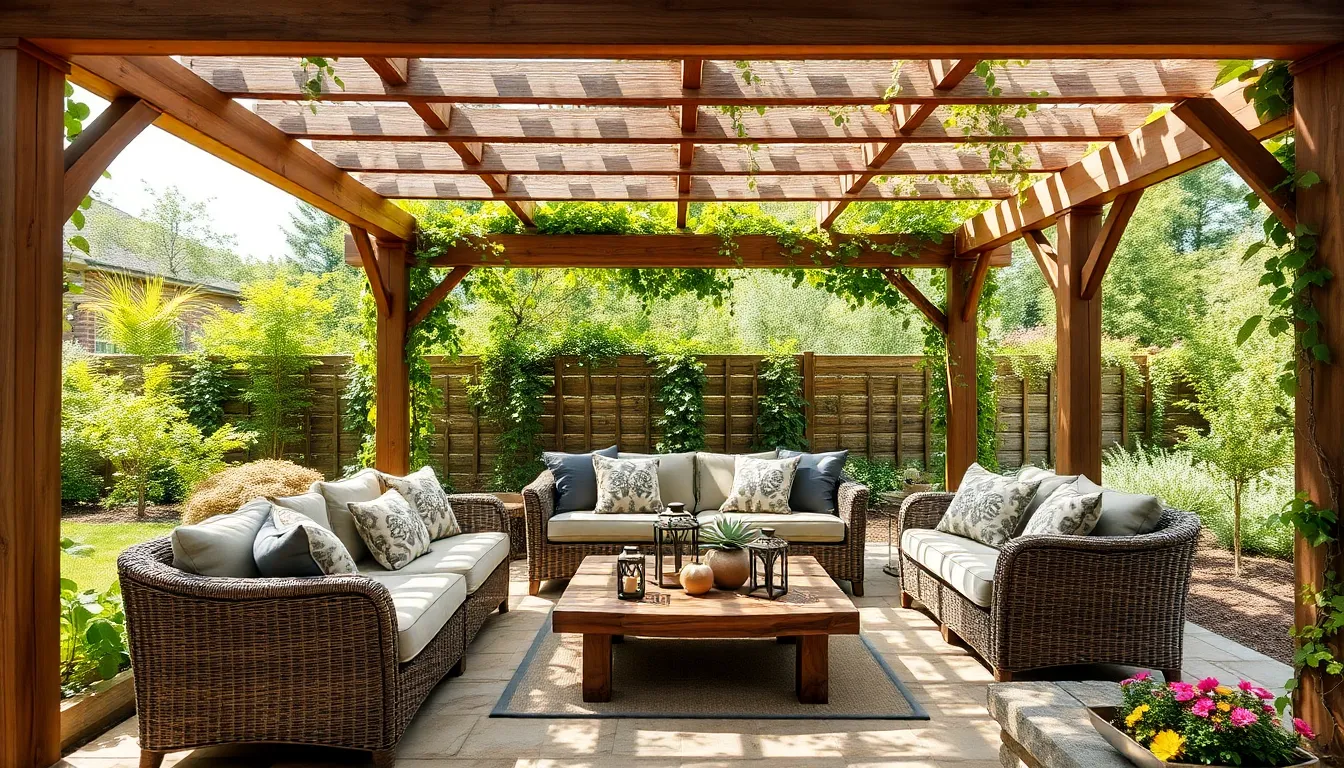Embrace the allure of the great outdoors by transforming your backyard into a rustic retreat with the charm of a pergola. Whether you’re a seasoned gardener or just beginning to explore the possibilities of outdoor living, pergolas offer an inviting framework to enhance your outdoor space. Their natural aesthetic not only provides shade and structure but also sets the stage for a cozy, nature-inspired ambiance.
In this article, we’ll explore 15 rustic pergola designs that seamlessly blend with the beauty of your surroundings. Discover how these structures can elevate your outdoor experience, from incorporating organic materials to selecting the perfect layout for your lifestyle. Whether you’re dreaming of a quaint nook for solitude or a lively gathering space, you’re sure to find inspiration and practical tips to bring your vision to life.
Incorporating Nature-Inspired Pergola Elements
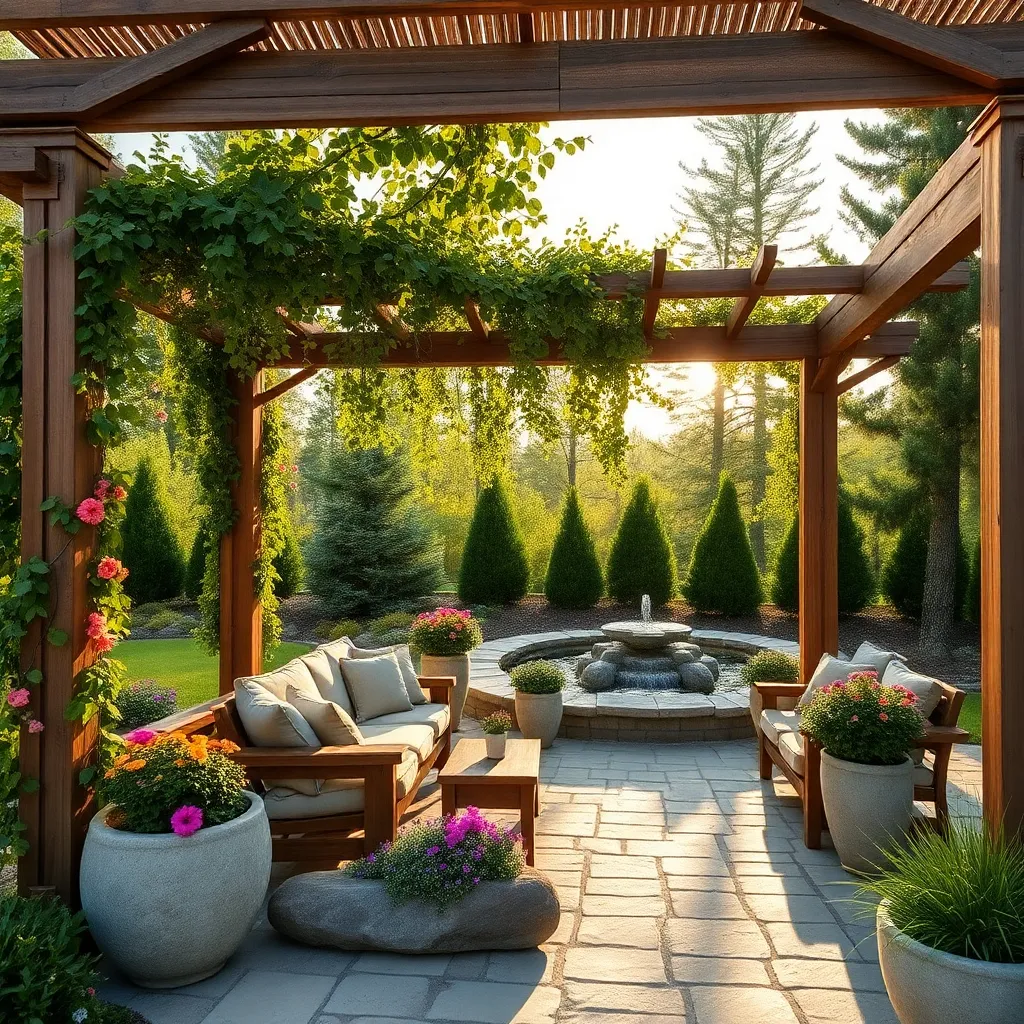
Embrace the beauty of nature by incorporating rustic elements into your pergola design. Consider using natural materials like untreated wood or bamboo to create a structure that blends seamlessly with its surroundings. For a more advanced touch, try integrating climbing plants such as wisteria or grapevines, which not only add aesthetic appeal but also provide natural shade over time. Beginners can start with simple, untreated wooden beams, while seasoned DIY enthusiasts might explore combining timber with stone or metal accents for added durability and style.
To enhance the rustic charm, focus on incorporating organic shapes and textures. Opt for curved beams or irregular stone bases to mimic nature’s imperfect beauty. Use a mix of materials like weathered wood and metal to contrast and complement each other, creating a harmonious feel. For those seeking a more intricate design, consider adding features such as a lattice roof or decorative carvings in the wood, which can serve both an aesthetic and functional purpose by allowing dappled sunlight to filter through.
Choosing Rustic Wood for Durability

Opting for rustic wood can significantly enhance the durability and aesthetic of your pergola. Cedar and redwood are excellent choices due to their natural resistance to decay and insects, making them ideal for various climates. For beginners, these woods are easy to work with and require minimal maintenance, while more experienced gardeners might opt for enhancing wood with a natural oil finish to prolong its lifespan and accentuate its grain.
Consider incorporating large timber beams for a sturdy, rustic look that adds both visual and structural strength to your pergola. Ensure beams are at least 4×4 inches in dimension for stability, and space your support posts around 6 to 8 feet apart to provide adequate support. Advanced designers might explore using reclaimed wood for a truly unique design, adding character and sustainability to your outdoor space. By choosing the right wood, you’ll create a pergola that not only blends seamlessly with nature but also stands the test of time.
Integrating Pergolas with Garden Paths
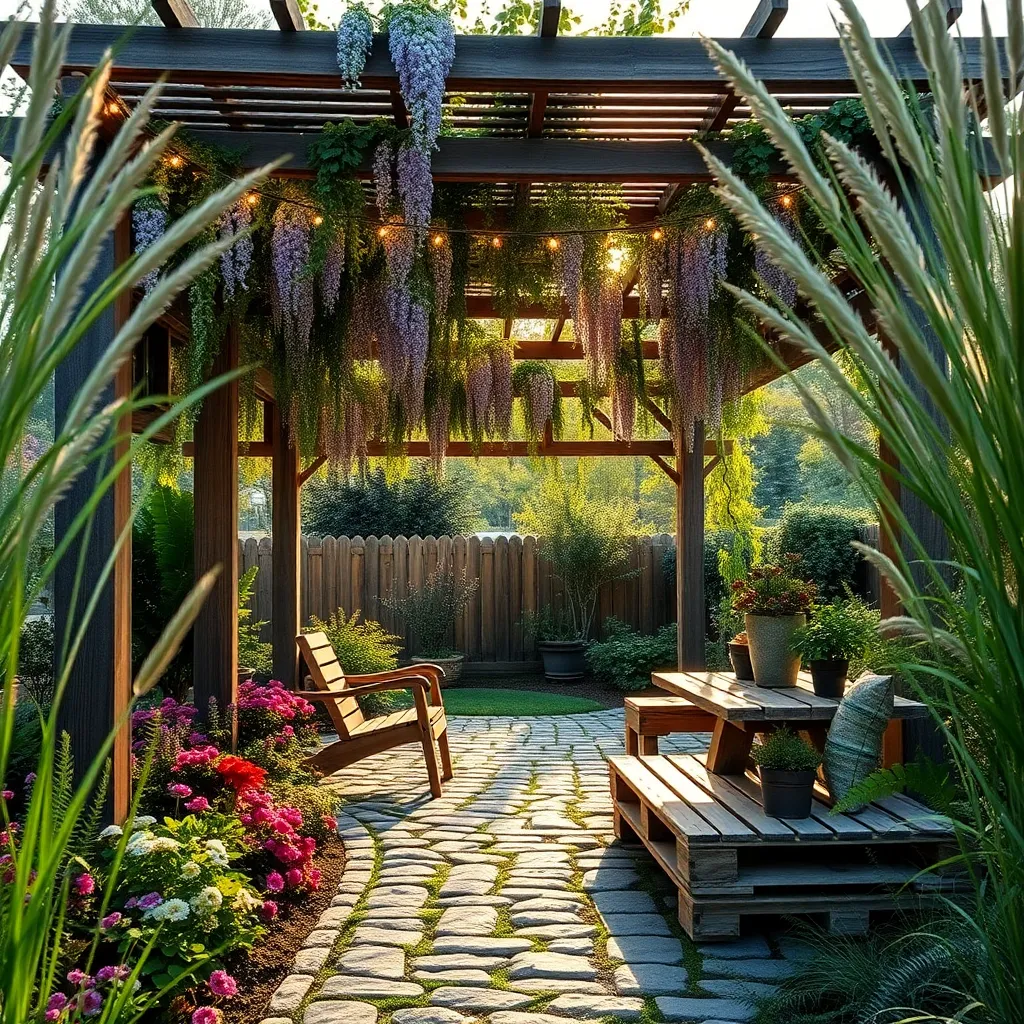
Integrating pergolas with garden paths can elevate the charm and functionality of your outdoor space. Begin by selecting materials that complement your garden’s theme, such as using the same type of rustic wood for both the pergola and path borders. This not only creates a cohesive look but also ensures durability and weather resistance. For beginners, consider a simple design where the pergola frames the path entrance, guiding visitors through a natural passageway. Use stone, gravel, or paver paths to match the rustic vibe while ensuring easy maintenance.
Advanced gardeners can enhance their pergola design by adding climbing plants like wisteria or jasmine, which will thrive on the structure and create a lush, natural canopy over time. Ensure the pergola is sturdy enough to support these plants by anchoring the posts securely into the ground using concrete footings. To add more character, incorporate decorative elements such as hanging lanterns or fairy lights along the path and pergola, providing both illumination and ambiance. Consider dimensions such as a path width of at least 3 feet to accommodate comfortable walking, and pergola spacing to allow plants to grow without overcrowding.
Enhancing Natural Light with Design
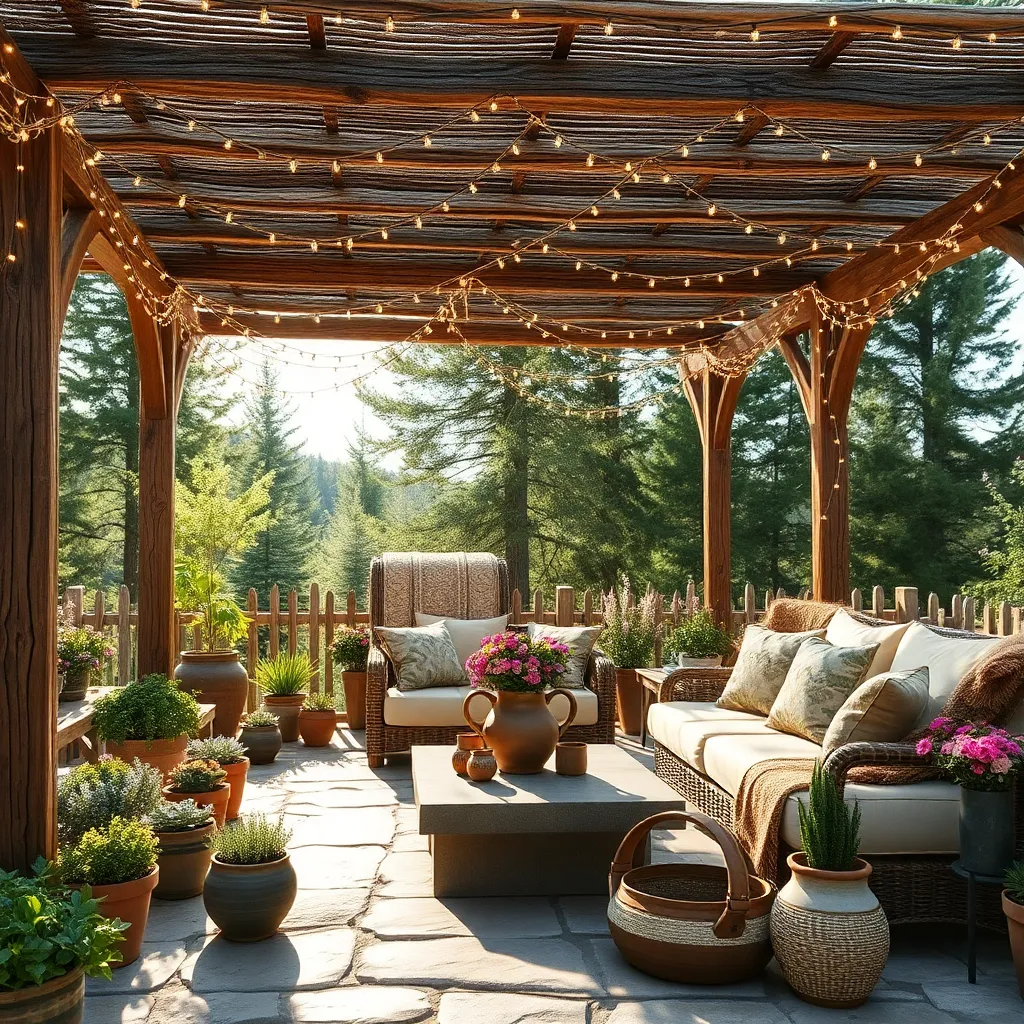
To enhance natural light in your pergola design, consider using light-colored materials such as pale wood or whitewashed finishes. These materials reflect sunlight, brightening the space beneath your pergola. For a more advanced touch, install a translucent polycarbonate roof, which allows light to filter through while providing protection from rain. This approach creates a serene and inviting atmosphere that encourages relaxation.
Incorporating strategic openings in your pergola design can further maximize sunlight. Opt for a latticework or slatted roof design that allows light to pass through while still offering some shade. Beginners can start with simple, evenly spaced slats, while experienced DIYers might experiment with angled slats to capture light at different times of the day. Position your pergola to take advantage of the sun’s path, ensuring maximum exposure and a naturally lit outdoor space.
Utilizing Reclaimed Wood for Character
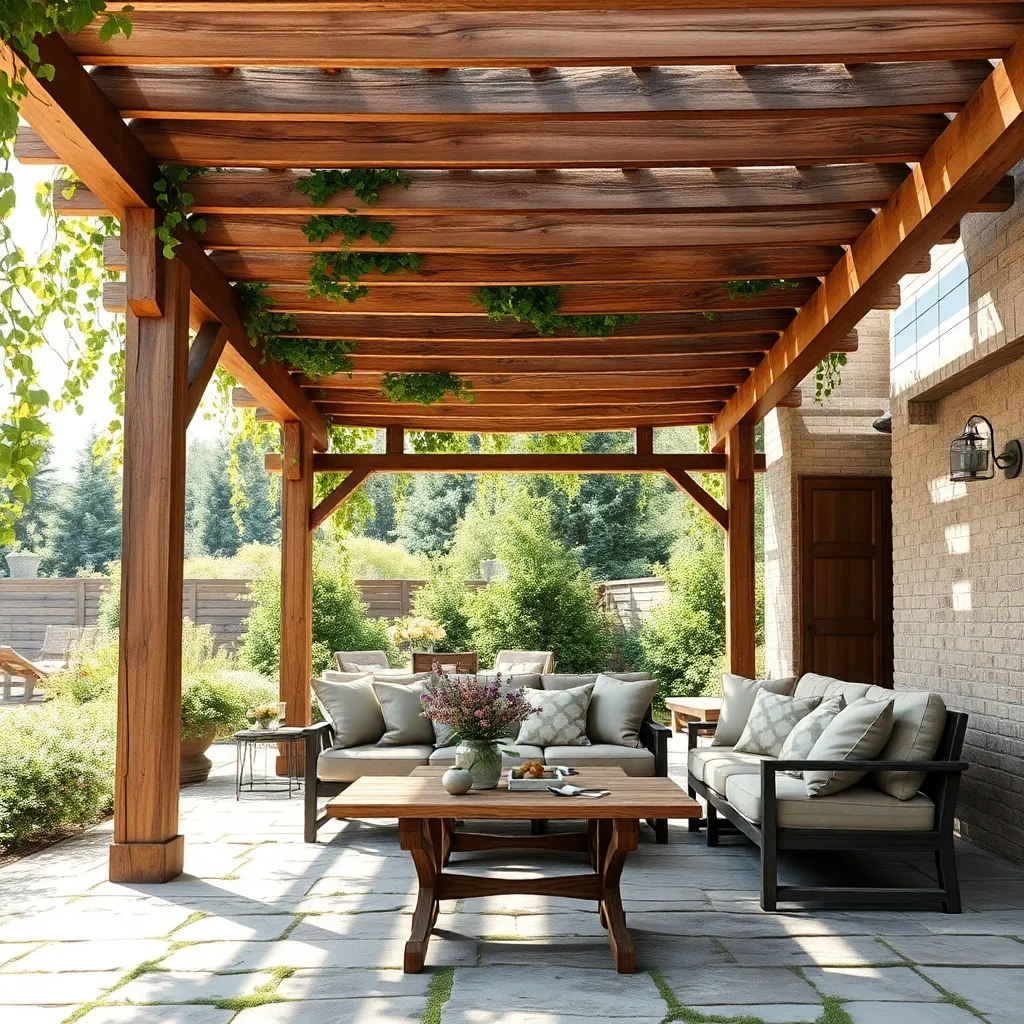
Reclaimed wood brings a unique charm to rustic pergolas, offering both sustainability and character. To start, source wood from local salvage yards or online marketplaces dedicated to reclaimed materials. Ensure the wood is structurally sound and treated for outdoor use to prevent rot. Incorporating aged beams or weathered planks can add an authentic, rustic feel. For beginners, a simple pergola design with a square or rectangular shape using standard 4×4 or 6×6 posts can be a straightforward project, while more experienced builders might experiment with arches or intricate joinery.
For a cohesive look, choose wood types that naturally complement each other, such as pairing oak with cedar. Emphasize the natural grain by applying a clear outdoor sealant to highlight the wood’s unique features while protecting it from the elements. Consider using reclaimed wood for additional elements like a built-in bench or a lattice screen to enhance the pergola’s functionality and aesthetic.
- Begin by measuring your space and marking post locations.
- Secure posts with concrete for stability.
- Use galvanized fasteners to prevent rust.
These simple steps will help you create a personalized outdoor retreat that blends seamlessly with nature.
Blending Pergolas with Landscape Views
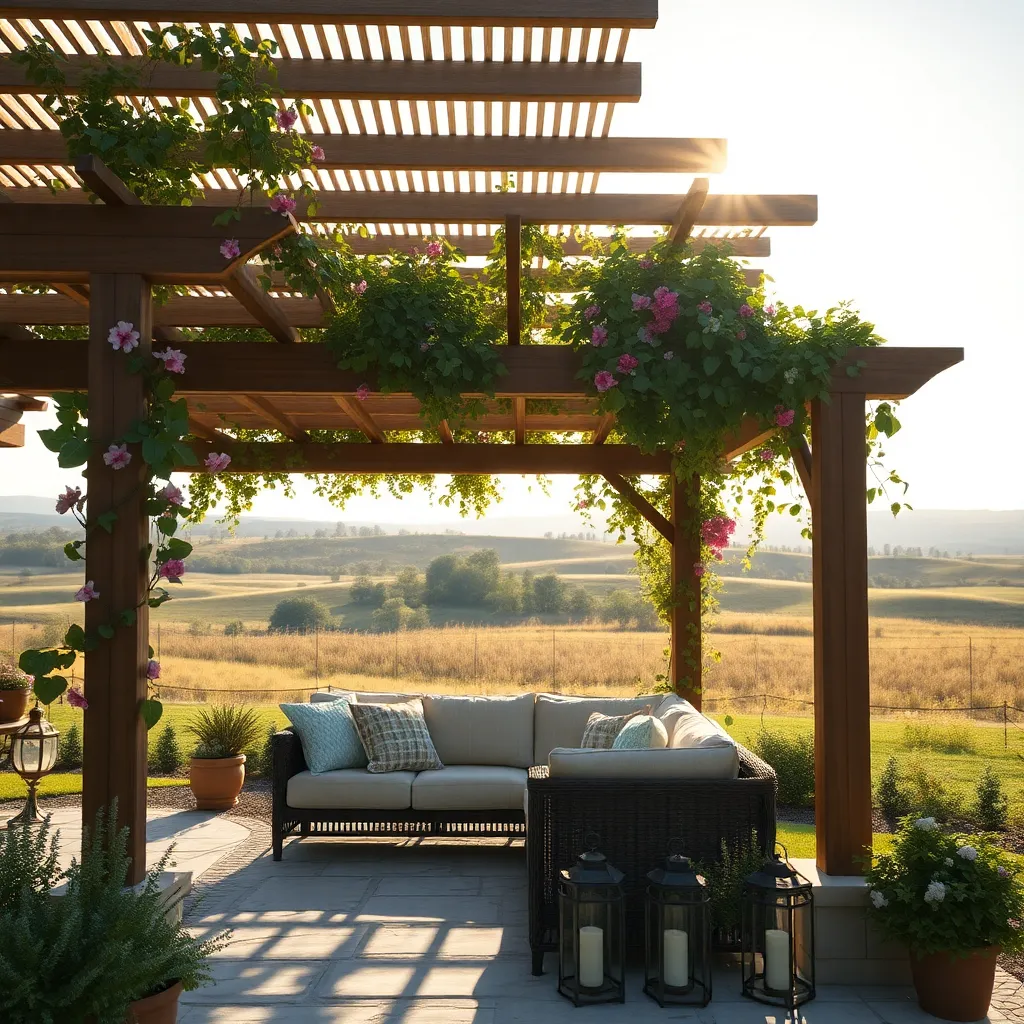
When blending a pergola with your landscape views, consider positioning it to frame a natural focal point such as a mountain range, a lush garden, or a serene body of water. Use materials that complement the surrounding environment, like weathered wood or stone, to create a seamless integration with nature. Beginners can start with a simple rectangular design, while experienced builders might opt for a hexagonal or circular shape to add visual interest and maximize viewing angles.
Enhance your pergola’s connection to the landscape by incorporating climbing plants like wisteria or grapevines, which can soften the structure and provide additional shade. For a more advanced project, consider adding a slatted roof that allows dappled sunlight to filter through, creating a dynamic play of light and shadow. Ensure the pergola is sturdy by using rot-resistant wood like cedar or pressure-treated pine, and anchor it securely with concrete footings for long-lasting stability.
Crafting Cozy Corners with Pergolas
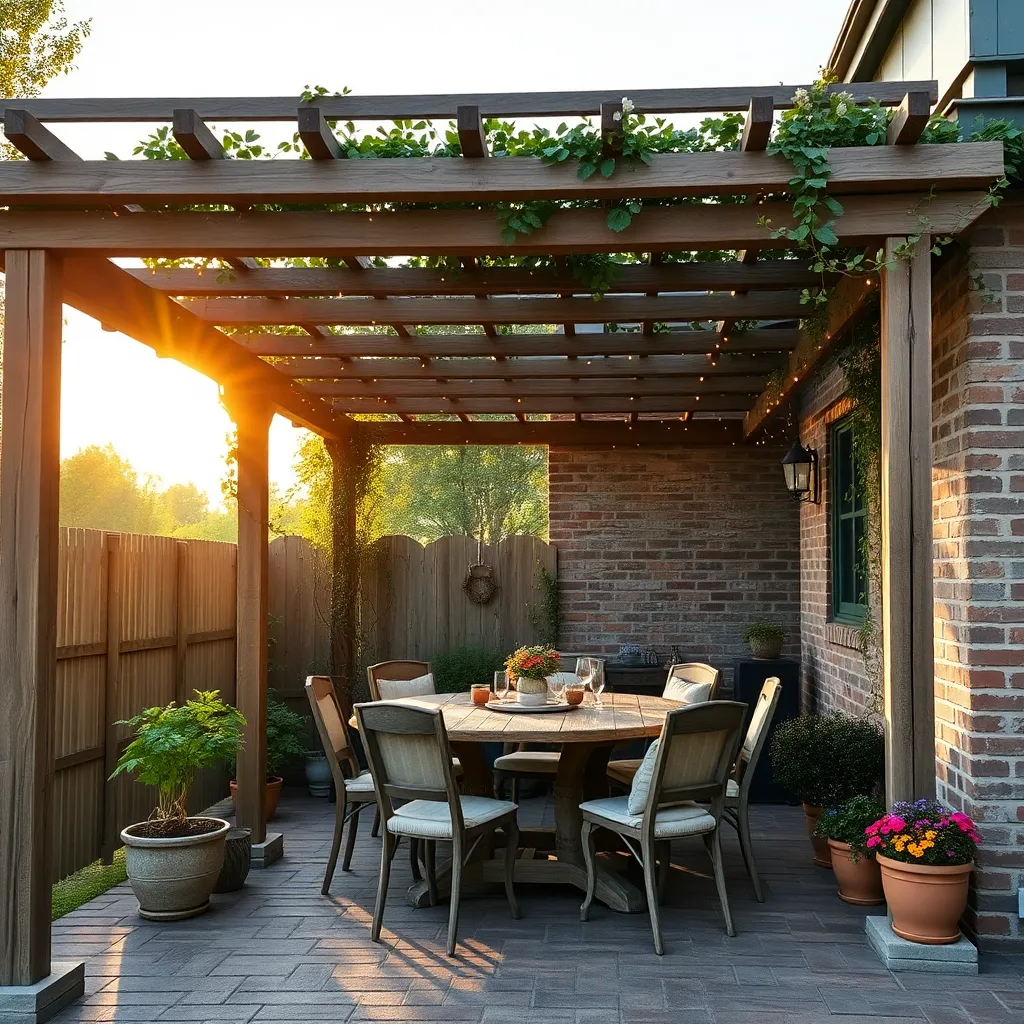
Creating a cozy corner with a pergola involves selecting the right materials and design to enhance comfort and aesthetics. Start with durable materials like cedar or pressure-treated pine, which offer both longevity and a rustic charm. To add warmth, consider integrating weather-resistant fabrics into your design, such as outdoor curtains or shade sails. Incorporate climbing plants like wisteria or jasmine, which can weave through the pergola slats, providing both shade and a touch of nature. Beginners can focus on simple, clean lines for a modern rustic look, while more advanced DIYers might explore custom latticework or intricate wood carving for added flair.
For a truly inviting atmosphere, incorporate practical elements like built-in seating or planters. Opt for benches made from the same wood as your pergola for a cohesive look, and add cushions with outdoor fabric for comfort. Lighting is crucial—use solar-powered string lights or lanterns to create a cozy glow during the evening. To ensure your pergola suits your space, measure the area carefully and choose dimensions that complement your garden’s scale. For those with more experience, consider adding a weatherproof outdoor fireplace or a small water feature to elevate the ambiance. With these elements, your pergola will not only be a functional shelter but also a charming retreat.
Adding Climbing Plants for Charm
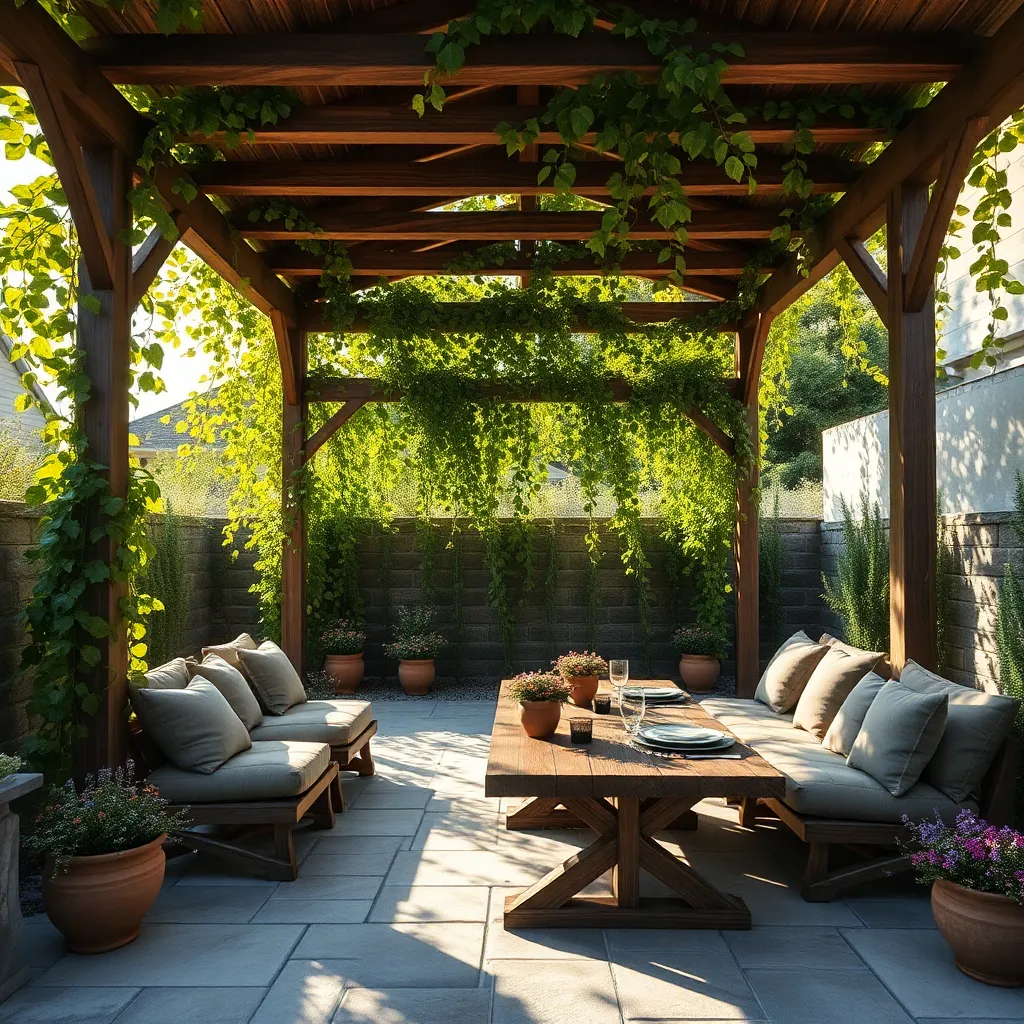
Incorporating climbing plants into your pergola design can add an inviting, rustic charm while providing natural shade and privacy. Start with easy-to-grow varieties like clematis or jasmine, which are well-suited for beginners because they require minimal maintenance and thrive in most climates. For a more advanced touch, consider using wisteria or passionflower—these climbers produce stunning blooms but need stronger support structures, so ensure your pergola is built with robust materials like cedar or redwood.
To maximize the beauty and functionality of your climbing plants, ensure they have the right trellis or wire support to guide their growth. Use galvanized steel wires or durable trellis panels attached to the pergola’s frame to help plants climb effortlessly. Spacing is crucial; plant climbers at least 12 inches from the base of the pergola to allow room for root expansion and moisture access. Regular pruning will encourage healthy growth and keep your pergola looking lush and inviting all year round.
Creating Shade with Organic Materials
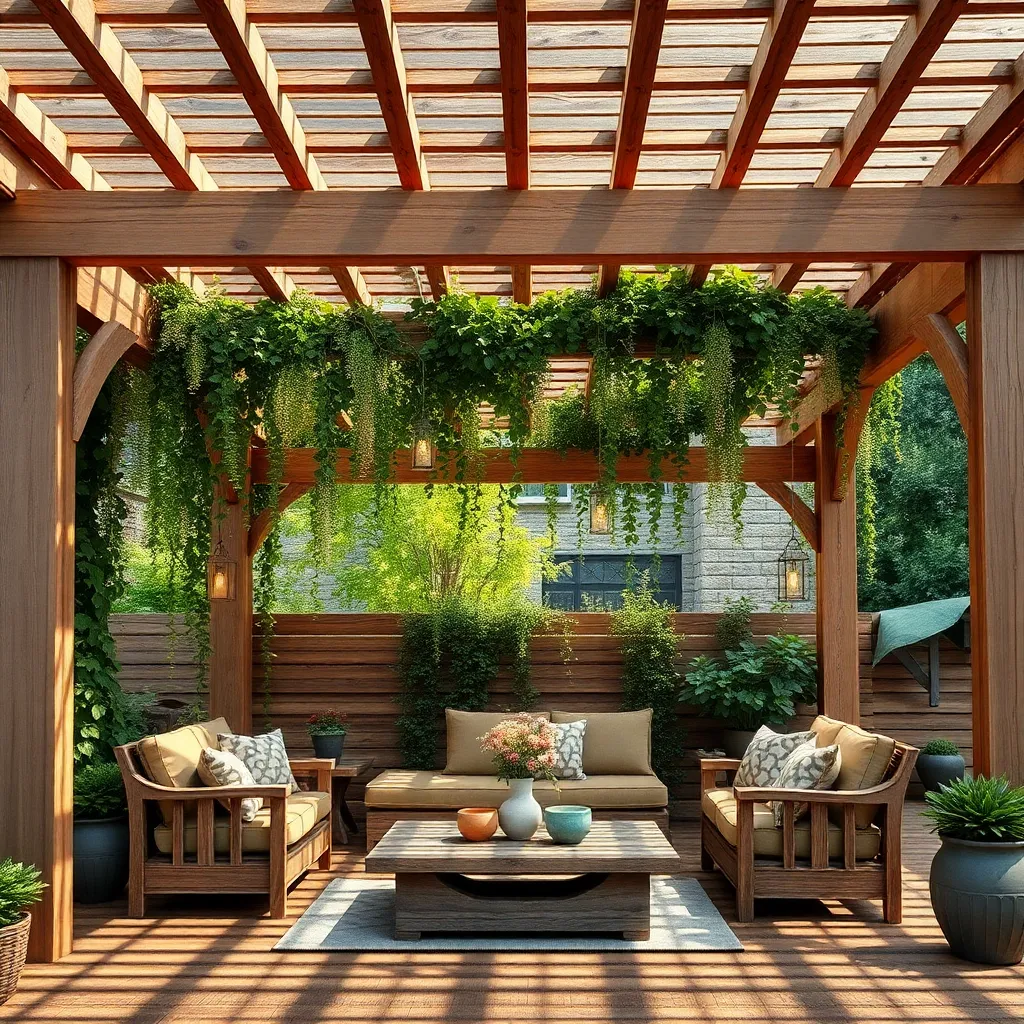
Incorporating organic materials into your pergola design not only enhances its rustic appeal but also offers practical shading solutions. Consider using natural materials like bamboo, willow, or woven reed mats to create a unique, earthy canopy. These materials are not only sustainable but also provide varying levels of shade and texture, allowing you to customize the ambience of your outdoor space. For a more advanced approach, you can interweave thin branches or twigs across the top for a rustic lattice that diffuses sunlight beautifully.
For beginners, starting with easy-to-handle materials such as pre-woven bamboo panels or willow hurdles can simplify the process. To ensure stability and durability, secure these materials with natural jute or sisal rope, which blends seamlessly with the rustic theme. If you’re looking for extra durability, consider treating the materials with a clear outdoor sealant to protect against weathering. By blending functionality with natural aesthetics, your pergola can become a stylish haven that invites relaxation and connection with nature.
Designing Pergolas for All Seasons
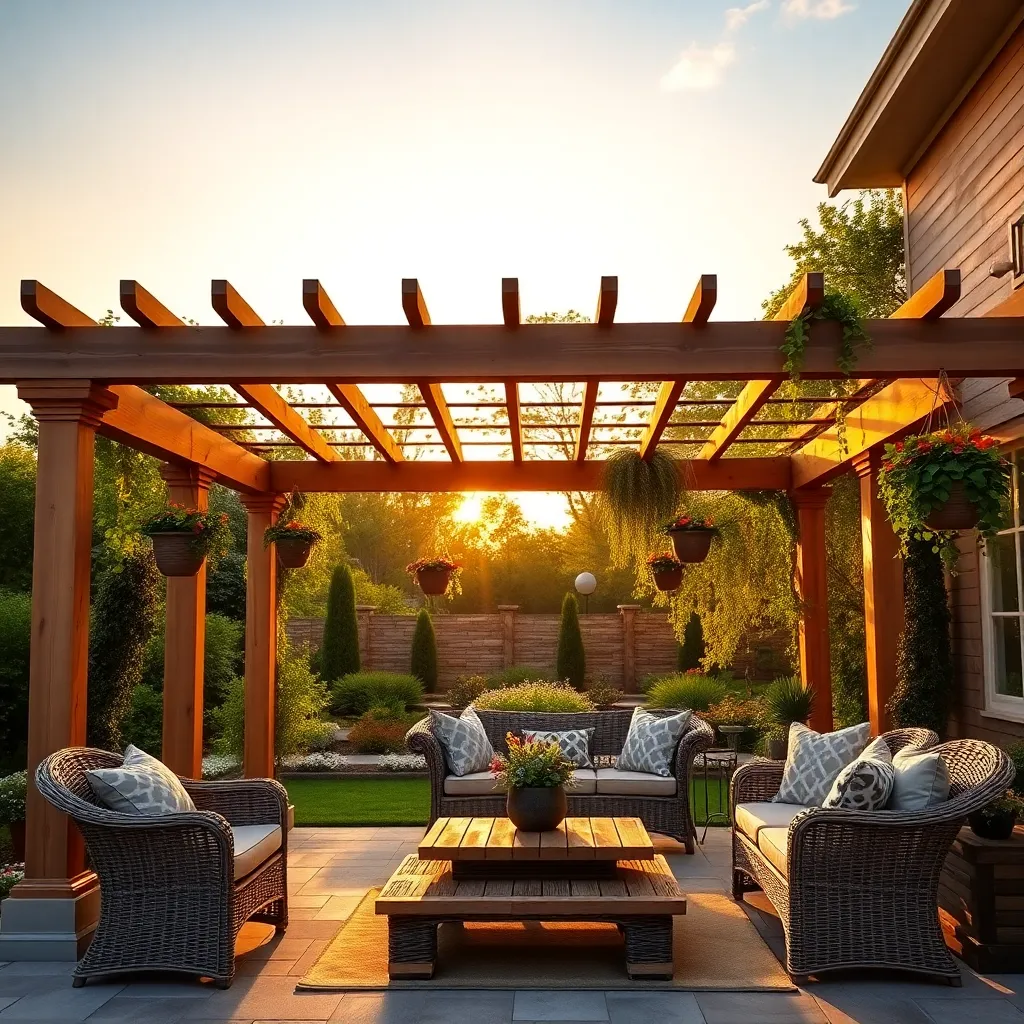
To design a pergola that thrives in all seasons, consider starting with durable materials like cedar or pressure-treated wood, which resist decay and withstand various weather conditions. Incorporate adjustable louvers or retractable canopies to adapt to changing light and temperature, ensuring comfort whether it’s sunny or rainy. Keep in mind that a typical pergola height of around 8 to 12 feet offers optimal overhead clearance while allowing for climbing plants or hanging decorations.
Beginner gardeners should focus on simple, clean lines and straightforward designs, while more experienced builders might experiment with incorporating intricate latticework or integrated lighting for added ambiance. For a functional year-round structure, include features like windbreaks or removable side panels to shield against winter winds and provide shade in summer. By combining these elements, you can create a versatile and inviting outdoor space that enhances any backyard setting.
Utilizing Natural Stone Accents

Natural stone accents can transform a rustic pergola into a stunning focal point in your garden. Incorporate stone columns or base foundations to anchor the pergola, providing both beauty and durability. Consider using locally-sourced stone like limestone or granite for a more authentic feel. For beginners, starting with simple stone pathways leading to the pergola can create a cohesive look. Ensure your stonework is well-sealed to withstand weather changes and maintain its charm throughout the seasons.
For a more advanced touch, integrate stone seating or a low stone wall around the perimeter of your pergola. This not only enhances the rustic aesthetic but also provides practical seating options. When planning your design, consider mixing stone textures—such as smooth river rocks with rugged slate—for visual interest. Don’t forget to factor in the pergola’s size; larger structures might require more substantial stone elements to maintain balance. Whether simple or intricate, natural stone accents can elevate your outdoor space and offer enduring elegance.
Personalizing with Rustic Decor Elements
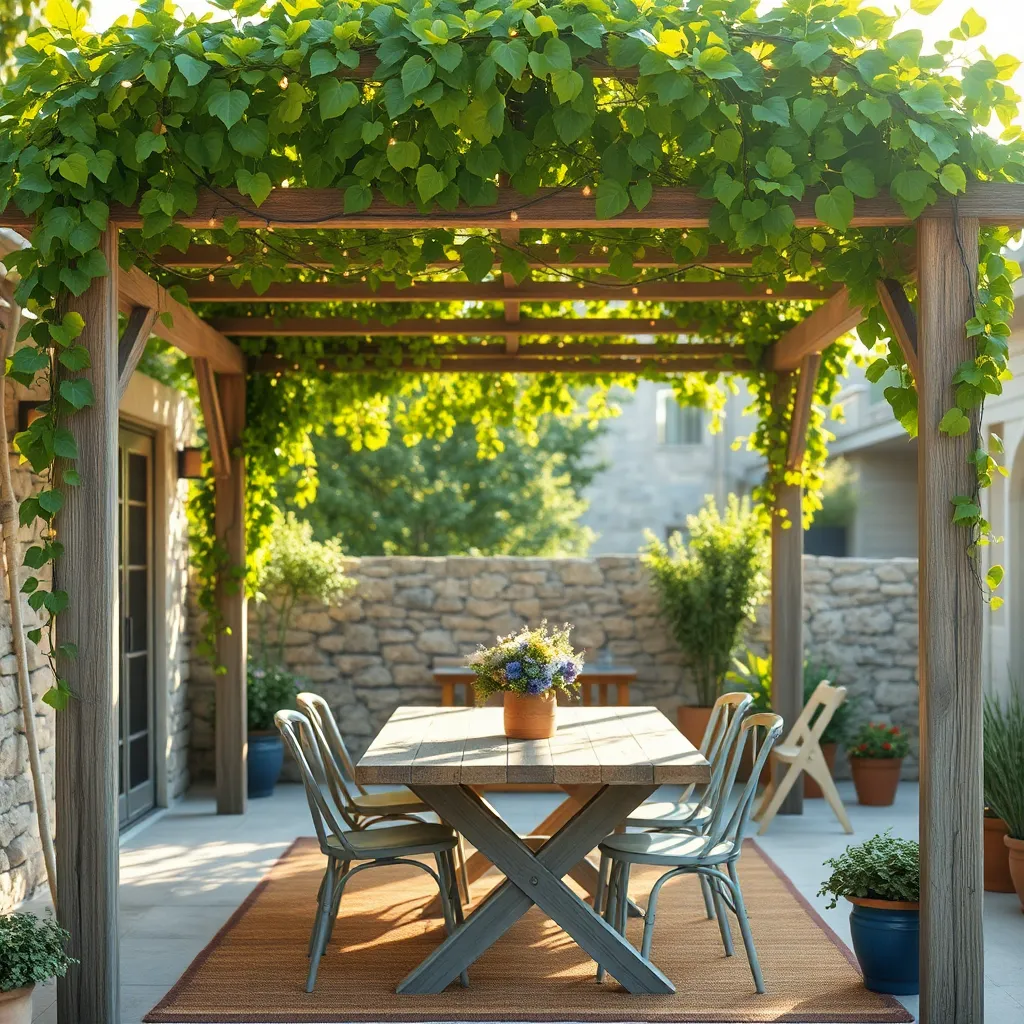
Infuse your pergola with a rustic charm by incorporating weathered wood elements, such as reclaimed barn wood or driftwood. These materials not only add a touch of history but also blend seamlessly with the natural surroundings. Consider using wood beams for the structure or as decorative crossbars, offering both support and style. For a more advanced touch, you can sand and seal the wood to protect it from the elements while highlighting its natural grain and texture.
Adding rustic decor can be as simple as incorporating vintage-inspired accessories like wrought iron lanterns or distressed metal planters. These items are both aesthetically pleasing and functional, providing ambient lighting or a home for cascading plants. For a personalized touch, try crafting handmade wind chimes from old metal tools or using burlap as a table runner on outdoor furniture. Keep your decor practical and weather-resistant, ensuring it complements the overall design while withstanding outdoor conditions.
Combining Pergolas with Fire Pits
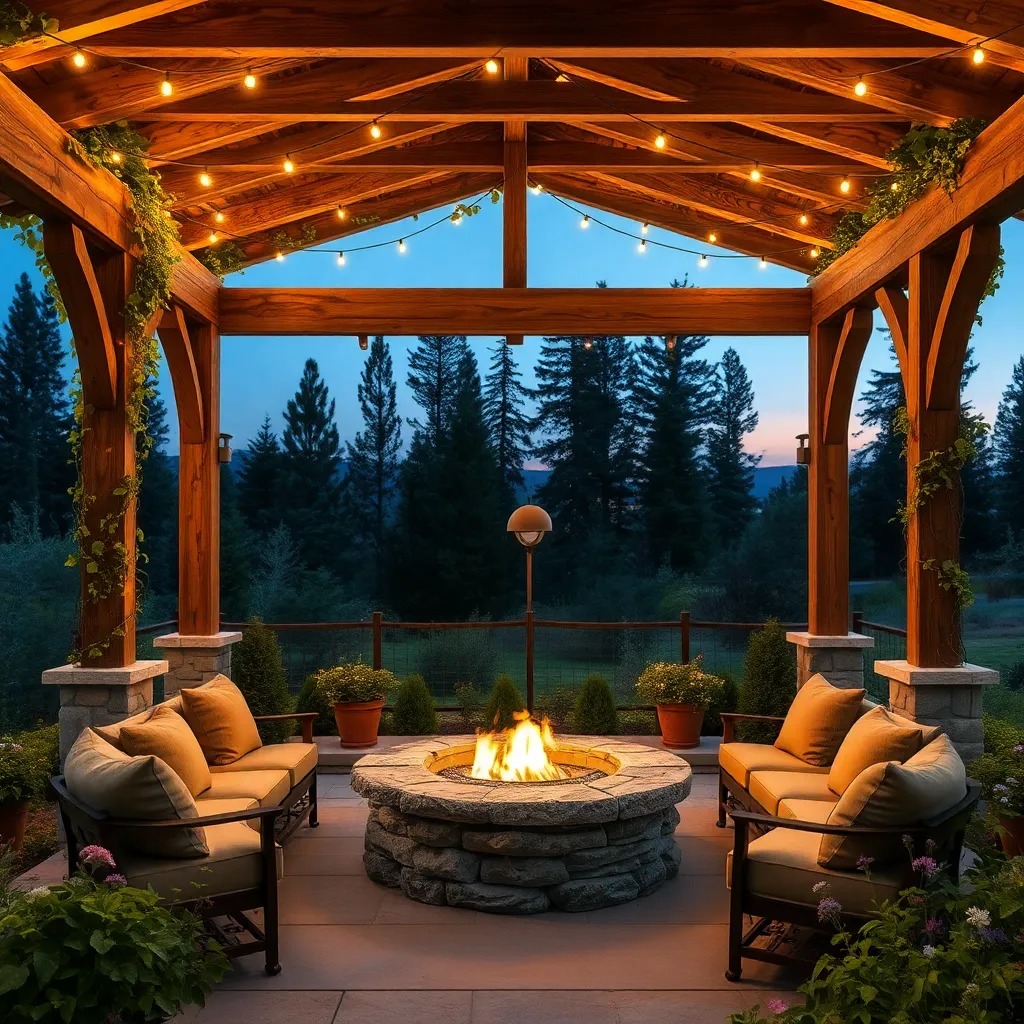
Integrating a fire pit with your pergola can transform your outdoor space into a cozy retreat. Start by choosing materials that harmonize with the rustic vibe of your pergola, such as a stone or brick fire pit to complement wooden beams. Ensure safety by maintaining at least 10 feet of clearance between the fire pit and any wooden structures. For beginners, consider a simple, prefabricated fire pit kit that ensures proper ventilation and structural integrity. This setup not only provides warmth but also serves as a focal point for gatherings.
For those looking to enhance the design, consider incorporating seating that encircles the fire pit, using durable materials like teak or cedar for a rustic, yet refined look. Advanced DIY enthusiasts might add built-in features like a firewood storage nook or a stone bench for added functionality. When designing the layout, plan for a circular or square fire pit that fits well within your pergola’s dimensions, generally leaving at least 3 feet of walking space around it. This thoughtful combination of pergola and fire pit will invite more use of your outdoor space, regardless of the season.
Maximizing Space with Multi-Level Designs

Creating a multi-level pergola design maximizes your outdoor space by introducing vertical layers, perfect for both small and large gardens. Start by using durable materials like cedar or pressure-treated wood for the main structure, ensuring longevity and weather resistance. Consider staggering the levels with varying heights to create interest and define different zones for dining, lounging, or gardening. For beginners, a simple two-tiered pergola can add depth, while more advanced projects might incorporate integrated planters or built-in seating on each level.
Enhance functionality by incorporating climbing plants like wisteria or jasmine, which can thrive on the different pergola levels, adding natural shade and fragrance. For a cohesive look, use complementary materials such as metal brackets or stone accents to tie the design together. Advanced DIYers can explore solar lighting on upper tiers for an eco-friendly touch that adds ambiance during nighttime gatherings.
- Begin with a detailed plan, considering dimensions and load-bearing requirements for each level.
- Consult a professional if uncertain about structural integrity, especially for multi-tiered designs.
With thoughtful planning, a multi-level pergola can transform your outdoor area into a stunning, functional retreat.
Crafting Intimate Pergola Dining Areas

Creating an intimate pergola dining area begins with selecting the right materials that blend functionality and aesthetics. Opt for durable woods like cedar or redwood, which are naturally resistant to decay and weather well over time. Consider incorporating climbing plants, such as wisteria or grapevines, to provide natural shade and enhance the rustic feel. For a beginner-friendly approach, start with a basic rectangular design that complements your outdoor space, ensuring the dimensions are large enough to accommodate your dining table and seating comfortably.
For those looking to add a touch of sophistication, integrate features like built-in lighting or retractable canopies. String lights or solar-powered lanterns can be woven through the beams for a cozy ambiance during evening meals. Advanced DIYers might explore adding a stone or brick base to anchor the structure, providing both visual appeal and stability.
- Ensure your pergola is anchored securely to withstand wind.
- Use weather-resistant finishes to protect the wood.
- Consider modular furniture that can be easily rearranged for versatility.
These elements come together to create a charming and functional outdoor dining space that invites relaxation and enjoyment.
Conclusion: Creating Beautiful Outdoor Spaces
In exploring ’15 Rustic Pergola Designs with Natural Vibes,’ we’ve delved into the transformative power of creating inviting outdoor spaces that echo the harmony found in healthy relationships. From embracing authenticity and fostering openness to celebrating individuality and nurturing growth, each pergola design symbolizes a unique aspect of relationship success. We’ve highlighted the importance of commitment and the beauty of blending diverse elements, much like the natural materials used in these stunning structures.
As a next step, consider dedicating time this week to create a cozy outdoor nook where you and your partner can unwind and connect. This simple action can serve as a tangible reminder of the principles we’ve explored together.
Remember, nurturing relationships is an ongoing journey. Bookmark this article to revisit these concepts and draw inspiration whenever needed. By saving this guide, you’ll have a handy reference to keep your relationship grounded in love and mutual growth.
Looking forward, envision your relationship flourishing as you continue to cultivate these natural vibes, growing stronger and more resilient with each passing day. Let this be the beginning of a beautiful, enduring journey together.

